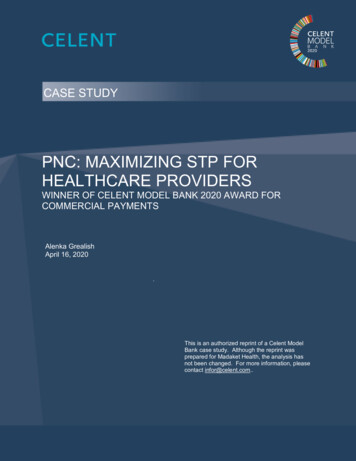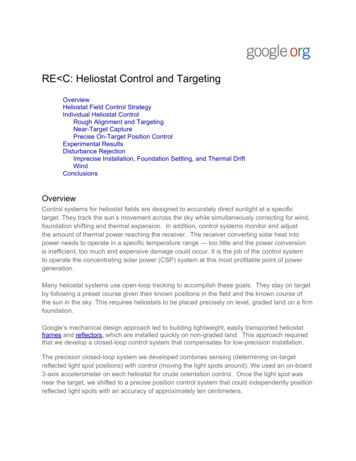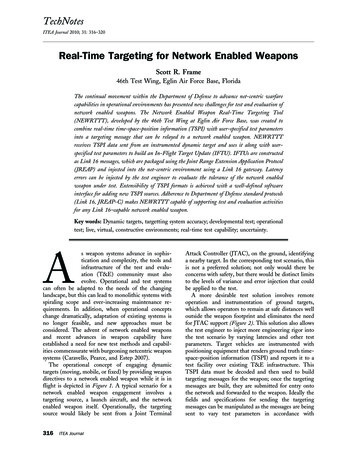
Transcription
Chapter 9STP: Segmentation,Targeting, andPositioning
Today Outline the different methods of segmenting a market Describe how firms determine whether a segment is attractiveand therefore worth pursuing Articulate the differences among targeting strategies:undifferentiated, differentiated, concentrated, or micromarketing Define positioning and describe how firms do it2
The big luePromotionCapturingvaluePriceCustomer acquisitionMarketinganalysis(understandingyour business)Customer retentionPROFIT3
STP ProcessImportant for group projects4
Step 1: Establish overallvision or objectives for your marketing strategySegmentation strategy MUST be consistent with– Firm’s mission/objective– Firm’s current situation (SWOT)5
Step 1: Establish OverallVision or Objectives for your Marketing StrategySegmentation strategy MUST be consistent with– Firm’s mission/objective– Firm’s current situation (SWOT)“Coca-Cola’s objective is to increasesales in a mature industry.” If this isour objective:1. What research should we be doingabout our consumer?2. Who is our consumer?3. What benefits is he/she seeking?The above questions lead you throughthe STP process.6
Step 2: Segmentation MethodsSegmentation MethodSample SegmentsGeographicContinent: North America, Asia, Europe, Africa. Within theUnited States: Pacific, mountain, central, south, midAtlantic, lAge, gender, incomeLifestyle, self-concept, self-valuesConvenience, economy, prestigeOccasion, loyalty7
Step 2: Segmentation MethodsGeographic Segmentation Consumers organized on the basis of where they livehttps://www.youtube.com/watch?v 6Pkq eBHXJ48
Step 2: Segmentation Methods9
Step 2: Segmentation MethodsPsychographic Segmentation Consumers organized on the basis of lifestyle and values10
Step 2: Segmentation MethodsBehavioral Segmentation Consumers organized on the basis of how they use theproduct/service11
Step 2: Segmentation MethodsBehavioral Segmentation Consumers organized on the basis of how they use ngthen-your-marketing12
STP13
Step 3: Evaluate Segment Attractiveness14
Step 3: Evaluate Segment AttractivenessIdentifiable Who is in their market? Are the segments unique? Does each segment require a unique marketing mix?15
Step 3: Evaluate Segment AttractivenessSubstantial Too small and it is insignificant – can you create an effective message toreach the segment in question?Too big and it may be impossible to craft a message that resonatesequally with all the members of your chosen “segment”!Effective segmentation is critical, even if your product has a generalmarket appeal.16
Step 3: Evaluate Segment AttractivenessReachableKnow the productexistsUnderstand whatit can doRecognize how tobuy17
Step 3: Evaluate Segment AttractivenessResponsiveCustomers in each segment must:React positivelyto firm’s offeringAccept thefirm’s valuepropositionTrust your firm!(Reputation,ethics)Benefits to be receivedfrom a product or service18
Step 3: Evaluate Segment t sizeBusinesses75,0001,0001%20%Purchase behavior Purchase price Frequency of purchase 10012 times 50020 timesProfit margin percentage60%80%Fixed costs 400,000 1,000,000Segment profit 140,000?Segment adoptionpercentageImportant for group project!19
Step 3: Evaluate Segment t sizeBusinesses75,0001,0001%20%Purchase behavior Purchase price Frequency of purchase 10012 times 50020 timesProfit margin percentage60%80%Fixed costs 400,000 1,000,000Segment profit 140,000 600,000Segment adoptionpercentageImportant for group project!20
Step 4: Selecting a Target MarketThere are several targeting strategiesMass marketingUndifferentiatedTargeting geting narrowly21
Restaurant exampleAssume a restaurant is trying to market its new business. Using a differentiated marketing strategy, the restaurant can appeal to thecollege crowd by marketing cheap specials on food and drinks, the familycrowd by marketing kid-friendly meal options and table entertainment and tothe elderly by marketing senior discounts and early-bird specials. Using a concentrated marketing strategy, the restaurant can market itsconvenient location to a group of residents within 10 miles of the business. Using an undifferentiated marketing strategy, the restaurant can highlightits grand opening celebration.22
Step 4: Selecting a Target Market23
Step 4: Selecting a Target MarketWhole food target market Working parents, aged approximately 30 to 50 Diverse, multi-cultural, embrace opportunities to “try newfoods” Environmentally-conscious Sustainability, animal welfare, organically-grown foods areamong these consumers shopping priorities City and suburban Educated professionals (B.A., M.A., MBA, Ph.D., etc.) Seeking premium service Willing to pay premium prices for a specific grocery-shoppingexperience24
STP25
Step 5:Develop a Positioning StrategyPositioning methods––––Value (relationship price to quality)Salient attributesSymbolCompetitionWhat sets your product or service apart from the others(unique value proposition)? You already offer what theyoffer, but your company takes it to the next level!26
STP27
Positioning methodsPerceptual map– Display, in 2 dimensions, the position of the product in theconsumer mind– E.g., Car brands28
Tesla examplehttps://www.youtube.com/watch?v BCPaO1Sv-hE29
Segmentation strategy MUST be consistent with –Firm’s mission/objective –Firm’s current situation (SWOT) Step 1: Establish Overall Vision or Objectives for your Marketing Strategy “Coca-Cola’s objective is to increase sales in a mature industry.” If this is our objective: 1.What researchshould we be doing about our consumer?











